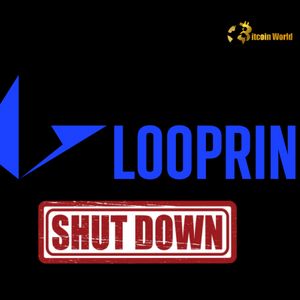Loopring Wallet Shutdown: Critical News for Users by June 2025
7 min read
BitcoinWorld Loopring Wallet Shutdown: Critical News for Users by June 2025 Hey there, crypto enthusiasts! We’ve got some important news impacting users of a popular Ethereum Layer 2 service. Loopring, known for its ZK-rollup technology, recently made an announcement that’s got many people talking. The core message? The Loopring Wallet service is scheduled to shut down. If you’re one of the many who rely on this particular crypto wallet , you’ll want to pay close attention to the details. Loopring confirmed via a post on X (formerly Twitter) that its native smart contract wallet service will be discontinued. The final date for this is set for the end of June 2025. While this might sound alarming at first glance, especially for those holding assets within the wallet, it’s crucial to understand what this means and, perhaps more importantly, what it doesn’t mean for the broader Loopring protocol and the Ethereum L2 ecosystem. Understanding the Loopring Wallet Shutdown Let’s break down the core announcement. The Loopring shutdown specifically targets the Loopring Wallet , which is a smart contract-based mobile wallet designed to interact seamlessly with the Loopring Layer 2 protocol. This wallet offered features like social recovery, daily withdrawal limits, and guardian features, aiming to provide a user-friendly and secure way to access the benefits of Layer 2 scaling on Ethereum. The decision to shut down a service like this is rarely made lightly. While the official communication often focuses on strategic shifts or resource allocation, the reality can involve various factors. It could be due to evolving market conditions, the cost of maintaining and developing the wallet compared to its user base, or a strategic decision to focus resources entirely on the underlying protocol technology rather than the end-user application layer. Without explicit detailed reasons from Loopring, much of the ‘why’ remains open to interpretation within the community. It’s important to distinguish between the Loopring Wallet application and the Loopring protocol itself. The protocol is the underlying infrastructure, the ZK-rollup technology that enables fast, cheap trading and transfers on Ethereum. The wallet was simply one interface for interacting with that protocol. The announcement clearly states the wallet service is shutting down, not the protocol. This distinction is vital for understanding the future of Loopring as a project. What Does the Loopring Wallet Shutdown Mean for You? If you are currently using the Loopring Wallet to store assets or interact with decentralized applications (dApps) on the Loopring Layer 2, this announcement has direct implications for you. The primary concern for users is the safety and accessibility of their funds. By the end of June 2025, the wallet application will cease to be supported and likely become inoperable or unsafe to use. This means you absolutely must take action before that deadline. Leaving assets in the wallet beyond the shutdown date could result in losing access to them, or at the very least, facing significant complications in retrieving them. This situation highlights a key aspect of self-custody in the crypto world: the responsibility lies with the user. While the wallet facilitated access, the underlying assets are on the blockchain, accessible via your private keys or recovery phrases (depending on the wallet type, Loopring Wallet uses a guardian/social recovery model). However, the *interface* provided by the wallet app is necessary for easy interaction. When that interface is removed, you need an alternative method. The good news is you have ample time – over a year – to plan and execute your migration strategy. This isn’t a sudden, overnight closure, giving users a significant window to move their assets safely. Ready to Migrate? Your Action Plan Before June 2025 Migrating your assets from the Loopring Wallet doesn’t have to be a stressful process if you plan ahead. Here’s a simplified guide on the steps you should consider taking: Assess Your Assets: Log into your Loopring Wallet and make a clear list of all the cryptocurrencies and tokens you hold within it. Note the quantities and types of assets. Identify a New Crypto Wallet: This is perhaps the most critical step. You need to choose a new Layer 2 wallet that supports the Loopring network or allows you to access your assets on the Ethereum L2 where they reside. More on finding alternatives below. Understand the Migration Process: Loopring is expected to provide official guidance on the safest and easiest way to migrate assets. Keep an eye on their official communication channels (their website, official social media). Generally, this will involve sending your assets from your Loopring Wallet address to your new wallet address. Perform a Small Test Transaction: Before moving all your funds, send a small amount of a low-value asset to your new wallet address. This confirms you have the address correct and the process works smoothly. Execute the Full Migration: Once you’re confident, transfer the rest of your assets to your new wallet. Double-check the destination address every single time. Secure Your New Wallet: Ensure you have properly backed up your new wallet’s recovery phrase or set up its security features (like hardware wallet integration or strong passwords) according to best practices. Stay Informed: Follow Loopring’s official channels for any updates or specific instructions regarding the shutdown process. Remember the deadline: end of June 2025. Don’t wait until the last minute! Starting this process sooner rather than later will give you peace of mind. Looking Beyond Loopring: Exploring Layer 2 Wallet Options The need to find a new wallet presents an opportunity to explore the diverse landscape of Layer 2 wallet options available for interacting with Ethereum L2 networks. Since your assets are on the Loopring L2, your new wallet needs to be compatible with this network. What kind of wallets should you look for? You’ll generally be looking for wallets that support connecting to Layer 2 networks like Loopring. These could include: Other Smart Contract Wallets: While less common than externally owned accounts (EOAs), other smart contract wallets exist that might offer similar features like social recovery. However, ensure they specifically support the Loopring L2. Standard Browser Extension/Mobile Wallets (like MetaMask, WalletConnect-compatible wallets): Many popular wallets that started on Ethereum Layer 1 now have support for connecting to and managing assets on various Layer 2 networks, including Loopring. You would typically add the Loopring network as a custom network or it might be pre-configured. These are often Externally Owned Accounts (EOAs), which function differently from smart contract wallets and rely on a single private key/seed phrase for recovery. Hardware Wallets: For maximum security, consider using a hardware wallet (like Ledger or Trezor) in conjunction with a compatible software interface (like MetaMask or Ledger Live if it supports Loopring L2 interaction) to manage your L2 assets. This keeps your private keys offline. When choosing a new crypto wallet , consider factors like security features (seed phrase storage, hardware wallet compatibility), user interface, supported networks (make sure it supports Loopring L2!), reputation, and community support. Do your own research (DYOR) to find the wallet that best suits your needs and technical comfort level. Is This the End for Loopring? Understanding the Protocol’s Future As mentioned earlier, the Loopring shutdown applies only to the wallet service, not the underlying protocol. The Loopring protocol, a leading Ethereum L2 ZK-rollup, continues to operate and evolve. Its core function is to provide a high-performance, low-cost platform for trading and payments on Ethereum using zero-knowledge proofs. The team’s decision to sunset the wallet likely indicates a strategic pivot towards focusing on the core protocol technology, developer tools, or other areas they believe will drive greater adoption and innovation within the L2 space. This isn’t necessarily a sign of the project failing; it could be a sign of maturity and a focus on its core strengths as a technological layer rather than an end-user application provider. Users and developers can still interact with the Loopring protocol using compatible third-party wallets and interfaces. The network remains active, processing transactions and supporting decentralized exchanges and other applications built on it. The future of Loopring the protocol seems to be centered on its role as vital infrastructure for scaling Ethereum. Benefits and Challenges Looking back, the Loopring Wallet offered significant benefits, primarily by providing a user-friendly gateway to the advantages of Ethereum L2 : incredibly low transaction fees and high transaction speeds compared to Layer 1. Its smart contract features like social recovery were also seen as innovative security measures. However, the challenge now is the disruption caused by the Loopring shutdown . Users face the challenge of migrating assets, which requires technical understanding and careful execution to avoid errors. There’s also the challenge of finding a new crypto wallet that meets their needs and offers similar ease of use or desired features, especially for those accustomed to the specific functionalities of the Loopring Wallet. This situation also highlights a broader challenge in the rapidly evolving crypto landscape: the reliance on specific applications or interfaces. While decentralization is a core tenet, accessing decentralized networks often requires centralized or specific software interfaces, which can be subject to change or discontinuation. Conclusion: A Call to Action for Loopring Wallet Users The announcement of the Loopring Wallet shutting down by the end of June 2025 is a significant piece of news for its users. It necessitates action to ensure the safety and accessibility of your digital assets. While the wallet service is retiring, the underlying Loopring protocol, a key player in the Ethereum L2 space, continues its mission to scale decentralized applications. This transition period, though potentially inconvenient, serves as a crucial reminder of the importance of managing your private keys or recovery methods and staying informed about the services you use. By planning your asset migration now and exploring suitable alternative Layer 2 wallet options, you can navigate this change smoothly and continue to participate confidently in the decentralized future powered by Ethereum’s scaling solutions. Don’t delay! Take the necessary steps today to secure your assets before the June 2025 deadline and transition to a new crypto wallet that supports your needs on the Loopring network or other preferred L2s. To learn more about the latest crypto market trends, explore our article on key developments shaping Ethereum price action. This post Loopring Wallet Shutdown: Critical News for Users by June 2025 first appeared on BitcoinWorld and is written by Editorial Team

Source: Bitcoin World


